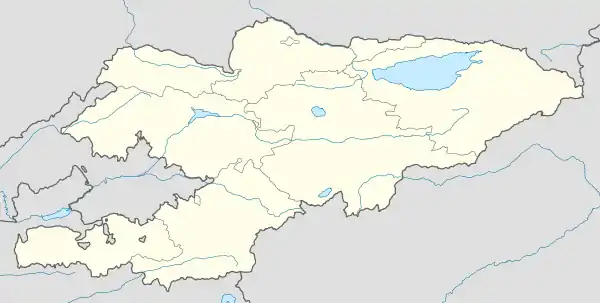2010年吉爾吉斯革命
2010年吉爾吉斯革命,或稱第二次吉爾吉斯革命(相較於2005年之「鬱金香革命」),是2010年4月6日至7日吉爾吉斯反對派推翻庫爾曼別克·巴基耶夫的革命。源於該國民眾對政府和總統巴基耶夫的不滿,特別是政府關閉多家媒體的行為。示威者4月6日控制了位於塔拉斯的政府辦公室,4月7日示威者與首都比什凱克的警察之間的衝突演變為暴力事件,並迅速蔓延至全國各地。至少已經造成100人死亡。[3][4]至4月7日晚,反對派已經成功推翻巴基耶夫政府,並組建了臨時政府,由前外長羅薩·奧坦巴耶娃擔任臨時總統。巴基耶夫已經通過他的私人飛機從首都逃離至南方城市奧什。 [5] 吉爾吉斯3任總統阿爾馬茲別克·阿坦巴耶夫係於2011年經該國人民直接普選產生。
| 2010年吉尔吉斯斯坦革命 | |
|---|---|
 一辆正在燃烧的军车 | |
| 位置 | |
| 日期 | 2010年4月3日 - 15日 |
| 死亡 | 88 |
| 受傷 | 1,000+[1] |
| 參與人數 | 约5,000名抗议者[2] |

比什凱克
塔拉斯
納倫
托克馬克
2010年4月吉爾吉斯革命主要分佈點
起因
巴基耶夫政府的腐敗和任人唯親,以及國家糟糕的經濟狀況,民眾不滿政府的經濟政策並要求降低物價、各種費用和稅收。[6] 在革命發生前幾天一些新聞媒體被政府關閉,這些媒體被視為傷害了總統和他的兒子。
过程
4月6日
4月6日,西部城市塔拉斯大約有1,000名示威者佔領了政府總部,當天晚上早些時候政府又重新奪回了政府大樓,然後又被示威者逼出。[7]兩名主要反對黨領袖塔克巴耶夫和阿爾馬茲別克·阿坦巴耶夫被政府逮捕。
國際反應
 俄羅斯副外長卡拉辛表示,「我們一貫的立場是,吉尔吉斯斯坦存在的所有政治、經濟以及社會方面的意見分歧都應該在民主程序的框架之內來解決」。他說,應避免流血事件的發生。俄羅斯外交部發言人安德烈·涅斯捷連科表示,俄方呼籲吉尔吉斯斯坦的集會者與執政當局放棄使用暴力。[13]總理普京7日表示:「無論是俄羅斯,還是我本人,以及俄官員,都與這些事件沒有任何關係」。俄總統梅德韋傑夫認為,這是吉尔吉斯斯坦的內政,吉國是俄羅斯的戰略夥伴,俄將對事態發展持特別關注。[14]
俄羅斯副外長卡拉辛表示,「我們一貫的立場是,吉尔吉斯斯坦存在的所有政治、經濟以及社會方面的意見分歧都應該在民主程序的框架之內來解決」。他說,應避免流血事件的發生。俄羅斯外交部發言人安德烈·涅斯捷連科表示,俄方呼籲吉尔吉斯斯坦的集會者與執政當局放棄使用暴力。[13]總理普京7日表示:「無論是俄羅斯,還是我本人,以及俄官員,都與這些事件沒有任何關係」。俄總統梅德韋傑夫認為,這是吉尔吉斯斯坦的內政,吉國是俄羅斯的戰略夥伴,俄將對事態發展持特別關注。[14]
參考資料
- . CBC News. 2010-04-10 [2010-04-19]. (原始内容存档于2010-04-12).
- The Economist: Tear gas, not tulips: An uprising watched throughout Central Asia, with implications for Russia and America, dated Apr 8th 2010
- Leonard, Peter, , Associated Press, April 7, 2010 [2010-04-07], (原始内容存档于2010-04-11)
- . [2010-04-07]. (原始内容存档于2010-04-12).
- . [2010-04-07]. (原始内容存档于2018-01-30).
- Tynan, Deirdre, , Wall Street Journal, April 7, 2010 [2010-04-07], (原始内容存档于2010-04-10)
- Siegel, Matt, , Sydney Morning Herald, April 7, 2010 [2010-04-07], (原始内容存档于2017-10-12)
- . [2010-04-07]. (原始内容存档于2012-07-08).
- . [2010-04-17]. (原始内容存档于2019-08-22).
- . [2010-06-13]. (原始内容存档于2019-12-02).
- . [2010-06-13]. (原始内容存档于2019-11-14).
- . [2010-04-07]. (原始内容存档于2019-09-09).
- . [2010-04-07]. (原始内容存档于2019-08-22).
- . [2010-04-07]. (原始内容存档于2018-09-02).
- . [2010-04-07]. (原始内容存档于2018-07-03).
- . [2010-04-08]. (原始内容存档于2010-06-11).
- . [2012-12-03]. (原始内容存档于2010-06-26).
外部連結
- Humanitarian information coverage on ReliefWeb(页面存档备份,存于)
- Exploring Regime Instability and Ethnic Violence in Kyrgyzstan(页面存档备份,存于) by Eric McGlinchey (Asia Policy, July 2011)
- One Year After Ethnic Riots in Kyrgyzstan: What Has Changed?(页面存档备份,存于), Q&A with Eric McGlinchey (National Bureau of Asian Research, June 2011)
- At Least 117 People Killed in Kyrgyzstan; An Estimated 80,000 Uzbeks Have Fled(页面存档备份,存于) – video report by Democracy Now!
- Calm Returns, Fear Remains, In Kyrgyzstan's South(页面存档备份,存于) – Audio report by NPR, 18 June 2010
- Crisis in Kyrgyzstan(页面存档备份,存于) – slideshow by Life magazine
This article is issued from Wikipedia. The text is licensed under Creative Commons - Attribution - Sharealike. Additional terms may apply for the media files.